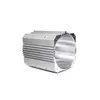Mobile:+86-311-808-126-83
Email:info@ydcastings.com
Exploring the Characteristics and Applications of Propeller Type Impeller in Fluid Mechanics Systems
Understanding Propeller Type Impellers Design and Applications
Propeller type impellers are a crucial component in various engineering and industrial applications, particularly in fluid dynamics and mixing processes. They are designed to efficiently move fluids, whether it be liquids or gases, and are characterized by their distinct blade shapes and configurations. Understanding the design, functionality, and applications of propeller type impellers can provide valuable insights into their role in modern technology.
Design Features
The design of a propeller type impeller is vital for its performance and efficiency. Typically, these impellers consist of two or more blades that are attached to a rotating hub. The blades are often shaped like the blades of a traditional boat propeller, designed to create lift as they rotate through a fluid. The pitch, diameter, and angle of the blades are all critical factors that affect the impeller's performance.
The pitch refers to the angle at which the blades are set, which influences the velocity and flow rate of the fluid being moved. A higher pitch generates a greater flow, while a lower pitch is better suited for applications requiring a higher head. The diameter of the impeller also plays an essential role; a larger diameter typically increases flow rates but may reduce pressure depending on the system design.
Material selection is another critical aspect of propeller type impeller design. Impellers are often made from metals, plastics, or composites, chosen based on the specific requirements of the operational environment, including temperature, pressure, and the nature of the fluid.
Functionality
As propeller type impellers rotate, they create a pressure difference between the high pressure on the blade's leading edge and the lower pressure on the trailing edge. This pressure differential forces the fluid to move, effectively pumping it from one location to another. The flow generated by these impellers can be laminar or turbulent, depending on the blade design and the speed of operation.
propeller type impeller

In applications requiring mixing, propeller type impellers help achieve homogeneity in the fluid mixture by inducing circulation and turbulent flow patterns. The impellers can impart energy into the fluid, ensuring that solid particles or chemicals are evenly distributed throughout the medium.
Applications
Propeller type impellers are widely used in various sectors, including chemical processing, wastewater treatment, food and beverage production, and marine engineering. In chemical processing, for example, they are often employed in reactors where mixing and uniform distribution of reactants are crucial for efficient chemical reactions.
In wastewater treatment plants, propeller type impellers are utilized in aeration basins to introduce oxygen into the water, promoting the growth of aerobic microorganisms that break down pollutants. The food industry leverages these impellers for mixing ingredients and ensuring consistent texture and flavor in products.
Marine applications also extensively use propeller type impellers in ship propulsion systems. The efficiency and effectiveness of these impellers directly impact the vessel's speed and fuel consumption, making their design a topic of constant innovation and improvement.
Conclusion
Propeller type impellers are indispensable in numerous industrial applications, providing essential functions in fluid movement, mixing, and aeration. Their design intricacies and operational principles play a significant role in optimizing processes across various sectors. As technology advances, the design and materials used in propeller type impellers will likely continue to evolve, enhancing their efficiency and expanding their range of applications. Understanding the dynamics behind these impellers is crucial for engineers and industry professionals aiming to maximize performance and sustainability in their respective fields.
-
What Makes Stainless Steel Pump Casting Essential for Modern Industries?NewsJul.14,2025
-
Revolutionize Your Engine Maintenance with Premium Aluminum and Cast Iron ComponentsNewsJul.14,2025
-
Precision Flow Engineering Starts with the Right Pump ComponentsNewsJul.14,2025
-
Maximize Efficiency: Explore Reliable Containment and Crop SolutionsNewsJul.14,2025
-
Discover Superior Performance with Advanced Turbo ComponentsNewsJul.14,2025
-
Boost Fluid Dynamics with Precision-Engineered Pump ComponentsNewsJul.14,2025











